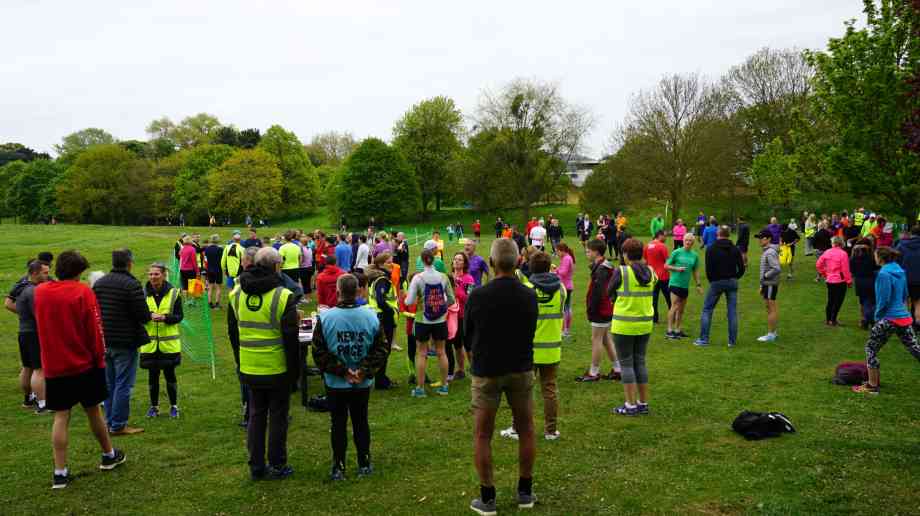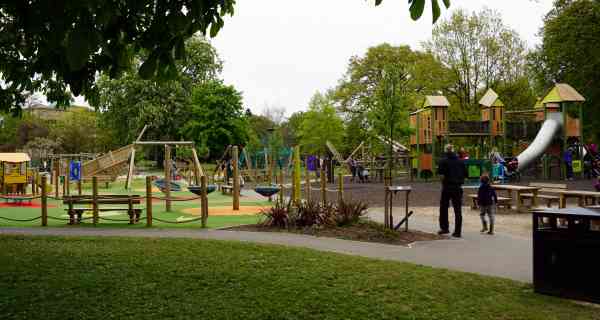Sue Robb of 4Children talks to Julie Laughton and Alison Britton from the Department for Education about the role of childminders in delivering the 30 hours free entitlement.

Fighting for our parks and green spaces
Denise Ewbank, of the British Association of Landscape Industries, discusses why we must fight for our parks and green spaces to be adequately funded, now and in the future
At a time when society faces so many challenges and the world order is being redefined, it’s difficult to make the case heard for something as passive as parks and green space. In living memory they’ve always been there and they demand nothing of us, not even an entry fee. We take them for granted and we think very little about the benefits we derive from using them.
As local authorities will attest, however, they do demand that we cherish and maintain them if those benefits are to be allowed to flow. And therein lies the nub: when there are pressing demands on stretched local authority budgets, where should parks and green spaces stand in the pecking order?
Working in the land-based sector you would expect me to make the case for increased, and even ring-fenced, funding for parks and green spaces. The British Association of Landscape Industries (BALI) has within its membership most of the companies contracted to local authorities to maintain their parks portfolios. These companies employ many thousands of horticulturalists, landscapers, tree surgeons and grounds maintenance operatives across the UK and the threat to their livelihoods if parks maintenance budgets are drastically reduced is real. Local authorities are also making directly employed parks staff redundant and this threatens a horticultural skills base that has been built up over many years. It is a very worrying state of affairs.
Albert Camus, the 20th century French philosopher, author and journalist, said that ‘by definition, a government has no conscience. Sometimes it has a policy, but nothing more’. In recent years, the government has pursued a policy of austerity in order to reduce our mounting national debt. The funding of parks and public green space has suffered as a result and, until recently, it appeared that the benefits and contribution they make to society had been ignored.
This country is facing an unprecedented obesity crisis in adults and, more worryingly, in children. According to Public Health England, 31.7 per cent of boys and 30.7 per cent of girls were overweight or obese in 2014. In Scotland and Wales there is an even higher prevalence of childhood obesity. Why, then, according to the recently published Nowhere to Play report, by the Association of Play Industries (API), are children’s playgrounds being closed at an alarming rate? 214 at the last count, with a further 234 earmarked for closure by local authorities. Short-sighted funding policy is exacerbating a problem that is just one of many ticking health time bombs waiting to explode.
Mental health, until very recently a taboo subject for open discussion, is now being regularly covered by the media. A common theme in ways to combat stress and depression is having access to outdoor green space and taking part in team sports and activities. If the two are combined there is benefit to mental and physical well-being. And with an NHS that is groaning under the weight of an increasingly ageing population, the longer we can keep people fit and active the less burden there will be on this gargantuan organisation that costs the country billions.
Addressing the state of UK public parks
BALI as a membership organisation – the largest in the UK representing landscape and grounds maintenance contractors, designers, and suppliers of industry-related products and services – has fought long and hard alongside other land-based organisations as part of the Parks Alliance to get the government to acknowledge the importance of parks and green spaces and to fund them appropriately. In 2016 The Heritage Lottery Fund’s (HLF) State of UK Public Parks report said that whilst the use of public parks is increasing, there is a continuing decline in the state of the infrastructure. The HLF has itself made significant investment in public parks in recent years but it can only do so much.
2016 also saw the announcement that there would be a Select Committee Inquiry into Public Parks, an indication that the message was getting through that the public would not stand for a degradation in park and green space provision and that something had to be done. The Select Committee published its findings on 11 February and there was recognition by the cross-party Communities and Local Government Committee that parks play a vital role in the communities they serve.
They asked the question ‘why do parks matter?’. The many contributions received from a broad range of stakeholders on the value of parks and the many challenges facing the parks sector led the Parks Minister, Andrew Percy MP, to commit to reporting back annually to Parliament on progress made in working proactively with local authorities on the consultation, development and implementation of green space strategies.
As recently as April 2017, the Association for Public Service Excellence (APSE) published its State of the Market Survey into Local Authority Parks and Green Space Services, which makes for very sobering reading. BALI contractors who currently hold fixed term local authority grounds maintenance contracts for parks and open spaces are already being asked to do more for less. The APSE survey shows clearly that local authorities are planning more cuts to their expenditure. When tendering for new contracts, BALI members must find innovative ways to deliver a service that can no longer be afforded. Additionally, they are now faced with funding the national living wage, workplace pensions, and the apprenticeship levy. These additional costs cannot be passed on within existing contracts and so the cost burden to these businesses is considerable.
Many contractors working for local authority clients have come together as members of BALI-NCF – the National Contractors’ Forum. This group of largely national companies held and ‘industry first’ Green Spaces seminar in the spring of 2016 and it clearly demonstrated the commitment of local authority officers and their service delivery partners to work together to find effective solutions to the crisis facing our parks. This client/contractor approach was continued with a second seminar, held at FutureScape 2016, an industry exhibition, where BALI-NCF joined forces with Parks for London to share how innovation and best practice being successfully employed by other industries could be harnessed to tackle the parks and green space sector’s own specific challenges.
Generating a running source of income
The APSE survey also showed that identifying ways of generating additional income is a prime concern for local authorities. There was quite a hoo-hah in the press a year ago when Stoke Gifford Parish Council, near Bristol, announced they would be charging the parkrun charity to use Little Stoke Park for the weekly Saturday parkrun. I have to come clean here as I am, myself, a regular parkrunner and I, along with between 400 and 500 other runners, make full use of the beautiful Pittville Park in Cheltenham most Saturday mornings. It is an amazing sight to see people of all ages – adults, children, parents, grandparents – lining up for their 5km run. I can’t think of any other sporting activity that gets as many people out on a regular basis. And when you consider that’s happening in parks across the country, it is, frankly, incredible. parkrun ticks all the boxes for demonstrating how parks and green space, i.e. managed landscapes, contribute to physical and mental well-being and, indeed, social cohesion, or ‘community togetherness’ if you prefer.
This amazing parkrun ‘movement’, for want of a better description, is obviously very important to the government. It promotes health, well-being and community engagement by involving the sort of numbers on a weekly basis other similar sport/health initiatives can only dream of. The problem lies in whether parkrunners should be treated as individuals with free use of parks, or whether, as part of the parkrun movement, they are charged for their Saturday morning activity, just like any other sports club using park facilities.
In an attempt to gauge public opinion the government launched the Running Free consultation in April to determine whether legislation should be passed to prevent local authorities and parish councils from charging parkrun for the use of public parks. I have no doubt that, if parks and green spaces were adequately funded, no council would want to deter people from using their local parks and would rejoice in them being utilised in such a positive way. Unfortunately, however, nothing can be off the table. Our parks and green spaces have to be cherished and maintained – and that costs money.
Birmingham City Council, originally proposing to spend just £9 million on its parks and green spaces, put their budget plans out to public consultation earlier this year. The people of Birmingham responded by placing parks in the top five services provided by the city council and, in an open letter, signatories from thirty local organisations said: “Birmingham’s parks and green spaces today are a source of our civic pride; they are the lungs of our city, a shared identity and the centre of many communities. We urge the council to rethink the immediate budget cuts to parks and green spaces." The council has subsequently announced it will increase its proposed parks budget by 25 per cent, from £9 million to £12 million.
If we are to call ourselves a civilised society we must continue to fund our public parks and green spaces at a realistic level. They contribute so much to the health and wealth of our nation – we simply need foresight to invest, knowing we will all reap the many rewards long into the future.

Company Focus
Just Lanyards is a subsidiary name of Gifts 2 Impress Limited, who have been trading for over 25 years, we therefore pride ourselves in having endless experience covering all aspects of the promotional merchandise industry.
Event Diary
UKREiiF has quickly become a must-attend in the industry calendar for Government departments and local authorities.
The multi-award-winning UK Construction Week (UKCW), is the UK’s biggest trade event for the built environment that connects the whole supply chain to be the catalyst for growth and positive change in the industry.
Supplier Profiles
Geo Energy
At GeoEnergy Design, we're on a mission to disrupt the traditional way heating and cooling ha
Latest Features
Professor Harith Alani, director of the Knowledge Management Institute at the Open University explains how AI can be used for good and bad.
Alex Lawrence, head of health & social care, techUK sets out techUK’s Five Point Plan for CareTech.












